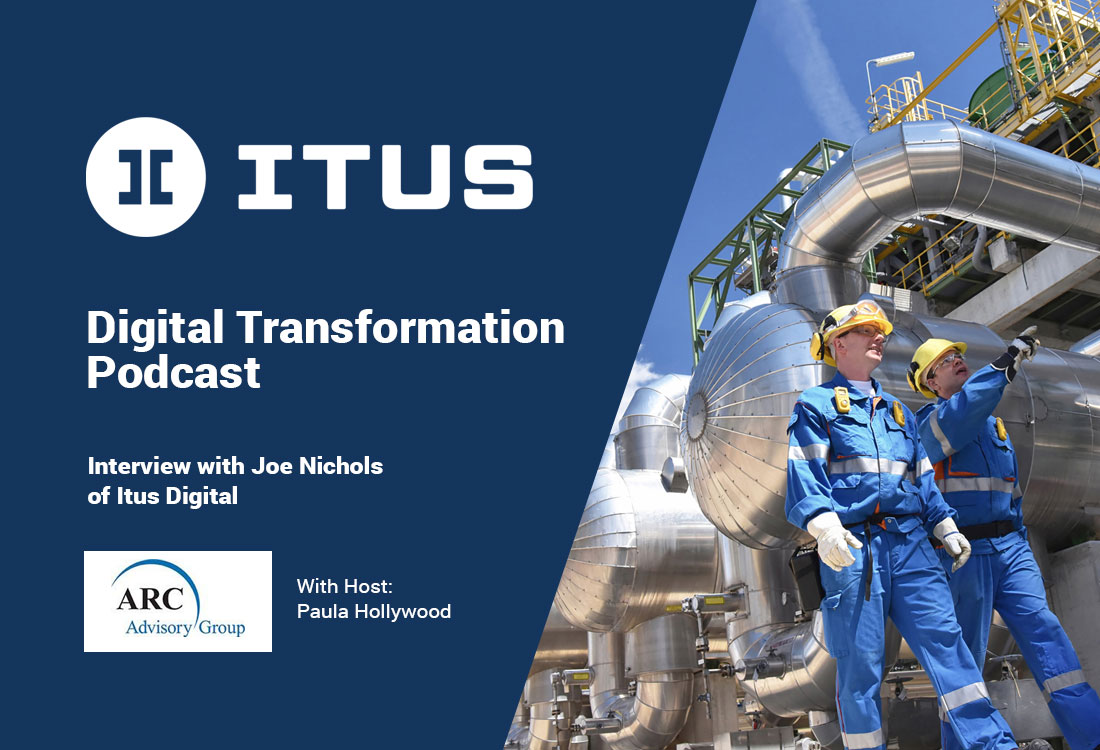Podcast: Why Now is the Right Time to Rethink APM
At Itus Digital, we believe that a good APM platform should scale with an organization’s growth without breaking the budget. A recent Markets and Markets report predicts that the asset performance management market will nearly double by 2026. It seems incredible, but more and more industrial organizations are looking to:
- meet regulatory compliance,
- create reporting standards,
- manage assets efficiently and sustainability and
- optimize total cost of ownership.
From their perspective, the market is fragmented, and there are many players.
For this reason, ARC Senior Analyst, Paula Hollywood recently interviewed Joe Nichols, Co-Founder and President of the newly launched Itus Digital.
Listen to this podcast or read on for the transcript as they discuss why
- the market needs to rethink APM,
- now is the right time to launch a new platform featuring digital twin technology,
- the focus needs to be on getting the asset strategy right from the beginning is essential.
APM Challenges Central to Genesis of Itus Digital
Paula’s opening question was, “You and the Itus team have a long history in the APM space. Can you tell us what motivated you to start a new APM company at this stage of market maturity?”
“We had multifaceted motivators for building an APM solutions company,” responded Nichols. He stated that the challenge of optimizing without increasing the operating costs and risks to people and the environment is their motivator. APM now has a proven value proposition; lower maintenance costs and risks and increase production and availability. Nichols believes that solution providers are not addressing large aspects of the APM market. The veteran APM team at Itus enjoys solving complex problems. Further, they think that a new approach and new business model could fundamentally shift the adoption of APM.
Addressing APM Challenges
When asked what APM challenges impacted the solution’s development, Nichols indicated three common themes. Their research uncovered:
- cost, particularly the considerable upfront costs associated with software licensing and implementation;
- the complexity of monolith applications stitched together via acquisitions typically using older, less efficient software architectures;
- and the capabilities of existing solutions.
Further, he elaborated that existing solutions are enterprise APM apps requiring large implementation teams, consulting services, or analytic/AI/ML applications to solve specific equipment anomalies or focus on anomaly detection.
Nichols summarized how Itus addressed those challenges. To solve cost concerns, Itus Digital offers subscription licensing based on actual usage. The company drives an onboarding process that completely de-risks the customer from massive up-front investments. It defined an efficient architecture that allows for on-premises or cloud-based deployment on-premises within minutes to lower complexity. And an intuitive user experience and workflow serve to simplify the process further.
Similarly, the company’s philosophy is that equipment and domain experts should be able to navigate the APM process easily and measure the APM program’s value. In terms of capabilities, the Itus platform is out-of-the-box ready, thus offering rapid time-to-value. Moreover, it fully integrates the implementation process for an asset strategy and tightly couples it with analytical models. This approach identifies when risks emerge, equipment health degrades, or when strategy activities are not completed. The company’s development team based this feature on an embedded and extensible asset strategy library covering 200 of the most common equipment types. Consequently, the combination of the Itus application process, strategy library, and asset twin models enables customers to be up and running rapidly.
Asset Twin Drives APM Value
When asked to explain the Asset Twin concept, Nichols addressed it in terms of the digital twin and acknowledged the variability in how that term is interpreted in the marketplace. In addition, he stressed the belief that the core constructs of a digital twin are critical for driving APM value. Itus views an Asset Twin as a software-defined asset, connected and analyzed in real-time to generate proactive insights as emerging threats are detected. Also, he believes that APM use cases, such as condition-based maintenance, failure prediction, and risk identification, must be firmly grounded with an asset strategy. Nichols summarized, “an Asset Twin is the fusion of an asset strategy with a digital twin. You must have both elements to ensure you optimize the performance of your assets.”
Taking a Different Approach
“Does using this methodology allow you to approach the APM market differently, and whom do you see as your target market?” asked Hollywood.
According to Nichols, “there are huge aspects of the industrial space that have challenges with unplanned failures, high maintenance costs, and the inability to identify emerging risks. The challenge these companies have is that APM only applies to a small portion of assets. Maybe they have limited IT and change management resources, or their particular ROI on APM initiatives does not align with existing solution costs, so they don’t do it. We have made APM easier across the board, but that does not mean organizations cannot use it in highly sophisticated APM environments. Our target market is anyone looking to solve for core APM use cases, such as equipment failure prediction, condition-based maintenance, or operational risk identification in an intuitive, scalable model that matches to their APM investment capability.”



